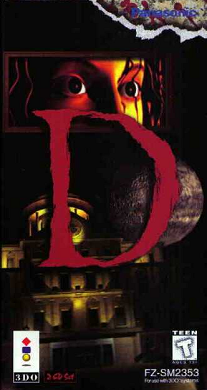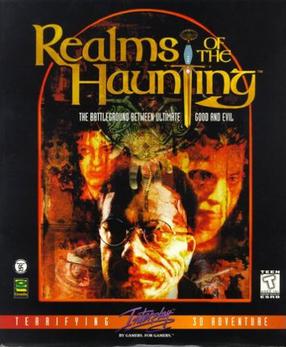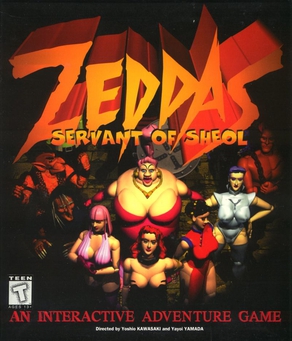
Quake is a first-person shooter game developed by id Software and published by GT Interactive. The first game in the Quake series, it was originally released for MS-DOS, Microsoft Windows and Linux in 1996, followed by Mac OS and Sega Saturn in 1997 and Nintendo 64 in 1998. In the game, players must find their way through various maze-like, medieval environments while battling monsters using an array of weaponry. Quake takes inspiration from gothic fiction and the works of H. P. Lovecraft.

Star Control: Famous Battles of the Ur-Quan Conflict, Volume IV is an action-strategy video game developed by Toys for Bob and published by Accolade. It was originally released for MS-DOS and Amiga in 1990, followed by ports for the Sega Genesis and additional platforms in 1991. The story is set during an interstellar war between two space alien factions, with humanity joining the Alliance of Free Stars to defeat the invading Ur-Quan Hierarchy. Players can choose to play as either faction, each with seven different alien starships which are used during the game's combat and strategy sections.

Riven: The Sequel to Myst is a puzzle adventure video game, the second in the Myst series of games. Developed by Cyan Worlds, it was initially published by Red Orb Entertainment, a division of Broderbund. Riven was distributed on five compact discs and released for Mac and Windows personal computers on October 31, 1997, in North America; it was later released on a single DVD-ROM in 1998. Riven was also ported to several other platforms. The story of Riven is set after the events of Myst. Having been rescued from the efforts of his sons, Atrus enlists the help of the player character to free his wife from his power-hungry father, Gehn. Riven takes place almost entirely on the Age of Riven, a world slowly falling apart due to Gehn's destructive rule.
An eroge is a Japanese genre of erotic video game. The term encompasses a wide variety of Japanese games containing erotic content across multiple genres. The first eroge were created in the 1980s, and many well-known companies in the Japanese gaming industry originally produced and distributed them. Some eroge are primarily focused on erotic content, while others, such as Key's Kanon, only contain occasional scenes in an otherwise non-erotic work. Games in the latter category are often re-released with sexual content removed for general audiences. Throughout its history, the genre has faced controversy for its use of explicit sexual content, and as a result has been banned from several console platforms.

Discworld II: Missing Presumed...!? is a 1996 point-and-click adventure game based on Terry Pratchett's series of fantasy novels set on the mythical Discworld, and sequel to the 1995 video game of the same name. The story sees players assume the role of Rincewind the "wizzard" as he becomes burdened with the task of finding Death and coercing him out of an impromptu retirement and back into his regular duties. The game's plot borrows from a number of Discworld books, including key elements from Reaper Man and Moving Pictures.

Discworld is a point-and-click adventure game developed by Teeny Weeny Games and Perfect 10 Productions and published by Psygnosis. It is based on Terry Pratchett's novels of the same name. Players assume the role of Rincewind the "wizzard", voiced by Eric Idle, as he becomes involved in exploring the Discworld for the means to prevent a dragon terrorising the city of Ankh-Morpork. The game's story borrows elements from several Discworld novels, with its central plot loosely based on the events in Guards! Guards!

The Space Bar is a 1997 graphic adventure game developed by Boffo Games and published by Rocket Science Games and SegaSoft. A comic science fiction story, it follows detective Alias Node as he searches for a shapeshifting killer inside The Thirsty Tentacle, a fantastical bar on the planet Armpit VI. The player assumes the role of Alias and uses his Empathy Telepathy power to live out the memories of eight of the bar's patrons, including an immobile plant, an insect with compound eyes and a blind alien who navigates by sound. Gameplay is nonlinear and under a time limit: the player may solve puzzles and gather clues in any order, but must win before the killer escapes the bar.

D is a horror-themed interactive movie and adventure game developed by Warp and directed by Kenji Eno. It was first published by Panasonic for the 3DO Interactive Multiplayer in 1995, later being ported to the Sega Saturn, PlayStation, and MS-DOS. The story follows Laura Harris as she goes to investigate a hospital after learning her father went on a mass murdering spree and barricaded himself inside. The hospital morphs into a castle upon her arrival, which she must explore to find her father. The player controls Laura through computer generated full-motion video (FMV) sequences, and must complete the game within two hours without a save or pause function.

Liquid Entertainment was an American independent video game developer based in Pasadena, California. The studio was founded in April 1999 by Ed Del Castillo and Mike Grayford.

Atlantis: The Lost Tales is a 1997 fantasy adventure video game developed and published by Cryo Interactive Entertainment. Interplay Productions published the game in North America, where it released on September 30, 1997. The game is named after its initial and most important setting, Atlantis. It is the first in a Myst-like series, and was followed by Atlantis II, Atlantis III: The New World, Atlantis Evolution and The Secrets of Atlantis: The Sacred Legacy.

Realms of the Haunting is a first-person adventure shooter game developed by Gremlin Interactive and published by Interplay Productions. It was released in 1996 for MS-DOS compatible operating systems. The 3D engine used in this game was borrowed from Gremlin's own Normality.
SegaSoft, originally headquartered in Redwood City, California and later San Francisco, was a joint venture by Sega and CSK, created in 1995 to develop and publish games for the PC and Sega Saturn, primarily in the North American market.

Rocket Science Games was a video game developer and publisher that created games for consoles and personal computers from 1993 to 1997. The company released Loadstar: The Legend of Tully Bodine, Cadillacs and Dinosaurs: The Second Cataclysm, Wing Nuts: Battle in the Sky, Rocket Jockey, and Obsidian. The Space Bar was the final game developed by Rocket Science. After the company folded, it was published by SegaSoft. Six additional games were never completed.

Rocket Jockey is a Windows video game created by Rocket Science Games and published by SegaSoft in 1996. The game's concept was developed by designer/lead programmer Sean Callahan, paired with an alternate reality 1930s America setting, conceived by VP of development/creative director Bill Davis. The player jets at high speed inside a grassy, enclosed sports arena on a rocket sled that is always in motion and chiefly steered with two grappling-hook guns mounted on its flanks. The rocket can change speeds but always flies about three feet off the ground unless it is engaged in one of the games' frequent and often-comic collisions.
An adventure game is a video game genre in which the player assumes the role of a protagonist in an interactive story, driven by exploration and/or puzzle-solving. The genre's focus on story allows it to draw heavily from other narrative-based media, such as literature and film, encompassing a wide variety of genres. Most adventure games are designed for a single player, since the emphasis on story and character makes multiplayer design difficult. Colossal Cave Adventure is identified by Rick Adams as the first such adventure game, first released in 1976, while other notable adventure game series include Zork, King's Quest, Monkey Island, Syberia, and Myst.

King's Quest: Mask of Eternity is a hybrid point-and-click adventure and action-adventure video game developed and published by Sierra Studios in 1998. It was the eighth official game in the King's Quest series, the first and only game in the main series where the main character is neither King Graham nor a member of his family, as well as the first in the series to use a full 3D engine as opposed to the 2D cartoon or pixel style of the earlier games and the first to omit the sequel numbering system on box artwork and title screen.

Jewels of the Oracle is a 1995 adventure game developed by ELOI Productions and published by Discis Knowledge Research Inc. It was released on Macintosh, PlayStation, Sega Saturn, and Windows. A sequel developed by Bardworks and published by Hoffman and Associates was released in 1998 entitled Jewels II: The Ultimate Challenge.

Loadstar: The Legend of Tully Bodine is a video game developed and published by Rocket Science Games for the Sega CD in 1994 and MS-DOS compatible operating systems in 1995.

Nemesis: The Wizardry Adventure is a 1996 adventure and role-playing video game developed and published by Sir-Tech. It is a spin-off of the Wizardry series of games. Ports for Sega Saturn and Microsoft Windows were released in Japan in 1998.

Zeddas: Servant of Sheol, also known as Horror Tour, is a horror adventure video game developed by Japanese studio Caravan Interactive, and published by Synergy Interactive in 1996 for Macintosh, SEGA Saturn, and Windows 3.

















